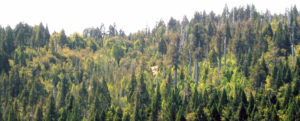
As Chile is still in the running for future GE tree plantations and will be hosting next years bi-annual IUFRO Tree Biotechnology Conference, I pass along this relevant article: A report on the evolution of forestry subsidies in Chile. This is an English translation from the original in Spanish linked here at Biodiversidadla.org – Anne Petermann
“This grant, even if it is delivered to small and medium landowners hardly lets them enjoy real gains, considering also that the high concentration of the sector means only three companies, which are the main buyers in local markets, determine the price of the raw material used for pulp, which is the main destination of forest production for smallholders. “
By Carolina Lagos Vasquez
Last November 2015, after the explosion of the economic scandal known as “the sign of comfort” (the expose showing that domestic companies colluded for a decade to fix prices of toilet paper, and involving major forestry companies), the Chilean government was forced to stop the spread of decree law 701, a law on forest development started in the seventies during the military dictatorship of Pinochet, to support private investment in the expansion of large-scale monoculture pine plantations and eucalyptus trees.
This decree provided for nearly 40 years of tax exemptions and state subsidies of between 75% to 90% of investments for the establishment of monoculture tree plantations. On one hand, the law contributed to a large concentration of land ownership and growth of the fortunes of some well-known families of the Chilean elite, who own most forest companies and cellulose, and also generated ecological, economic and social havoc in Chilean forests.
Social movements, environmentalists and indigenous peoples who had been denouncing its effects and protesting against this for more than a decade, applauded the death of decree law 701. Now, less than a year later, the government has announced the design of a new bill, supposedly with more noble intentions. In response to criticism of the DL 701 that mainly benefited large companies, the new plan would provide support only to small and medium landowners. But while this project is formulated, other subsidy instruments will be established to work “as a bridge between the past and the present,” in the words of director of the National Forestry Corporation (CONAF).
People are already raising concerns about this announcement because, since its establishment in 1974, including subsequent amendments, forestry subsidy always had “noble intentions”, like the use and recovery of degraded soils, reforestation (euphemism for monoculture plantations of pine and eucalyptus) and the possibility of economic activity for those who do not have the ability to make the large initial investment that this activity requires.
However, despite their stated purposes, in actuality, this new bill made is a key to the further development of a forestry model that today is considered the main factor responsible for the loss of native forest in Chile. These monoculture plantations have not only replaced native forests, but also depleted groundwater, subjecting entire communities and their animals to long droughts.
An example of this is the town of San José de la Mariquina, for more than four summers, the only source of water for 174 families from the 62 most affected villages, was delivered by tank trucks twice a week. Pollution is another major associated problem, as the main destination of forest plantations is the production of cellulose, a highly polluting activity.
A sad example of this is also found in the area Mariquina which has experienced massive death and migration of swans and other birds in the Nature Sanctuary Carlos Anwandter, due to pollution from the Arauco pulp mill (Celco ex) dumping into the water of the Pichoy and Cruces rivers. Indigenous communities, particularly the Mapuche people, have been displaced from their territories, forced to move to areas where they have little adaptation, or to finally settle in urban slums.
It is not unreasonable to conclude that this forestry subsidy, albeit delivered to small and medium landowners, will hardly make them enjoy real gains, considering also that the high concentration of the sector allows only three companies, which are the main buyers in local markets, to determine the price of the raw material used for pulp, the main destination of forest production of smallholders.
Thus the price of pulpwood logs has remained virtually “frozen” since the nineties, despite the rise in selling prices of cellulose in foreign markets. The benefits, therefore, are not being passed on to the small and medium producers, since they lack bargaining power. Therefore, the final beneficiaries of these promotion policies will remain the same: large companies with their known and scandalous history of collusion, environmental damage and millions in profits.
V. Lagos Carolina, is part of the Collective Wind South of Chile and the Advisory Council of the Global Forest Coalition.
